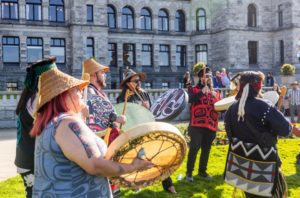
A commentary by a family doctor in Saanich: Never, in my 20 years of practice in B.C., have I seen family medicine in crisis as it is now. Trust me, it is not a new issue.
Dr. Jennifer Lush
Feb 7, 2022 5:03 AM
[Exerpt] I am a family doctor, and unless there is major primary care reform in this province, I may be one of a dying breed.
Never, in my 20 years of practice in B.C., have I seen family medicine in crisis as it is now. Trust me, it is not a new issue.
The writing has been on the wall for a long time, but we have been so busy working 70 hours a week, caring for patients, and trying to keep our small businesses afloat that we have stood by and watched government after government allow further erosion of primary care with no meaningful change.
I know many physicians who, themselves, do not have a family doctor and little hope of finding one; when my family doctor retires, I have no doubt my family and I will join the 700,000 (and steadily increasing) people in this province with no family physician.
I have watched valued and respected colleagues agonize over how they can continue to offer care to their patients but finally walk away from their practices, thoroughly burnt out and utterly demoralized.
The trouble is it feels like no one with the power to make effective change is listening. Here are a few ideas I would offer up, if I could sit down and have a chat with the health minister over a cup of coffee:
Pay us a wage commensurate to our training and professional status. Family physicians in B.C. are the second-lowest paid in the country, and as we all know, B.C. has the highest cost of living.
The fees paid to doctors have not increased in pace with the cost of living. Most have of us have paid for at least eight to 10 years of university on our journey to becoming a doctor, which translates to massive student loan debt.
Before we can even bill a dollar for patient care, we have to spend upwards of $7,000 annually on professional licensing fees, memberships and malpractice insurance.
Fair compensation for family doctors would still be good value for health care dollars invested. One study showed that people with a family doctor are 35 per cent less likely to be admitted to hospital. It has been proven over and over that a patient with a family doctor costs the health-care system thousands of dollars less annually than a similar unattached patient.
Unlike other small businesses, which can increase their fees to cover increased overhead, our income is limited by the government. Trust me, we would all much rather be practising medicine, which is what we were trained to do, than worrying about purchasing supplies, paying staff, etc.
The average family doctor visit pays about $32, and for most of us, 30-35 per cent of that will go to overhead. From the remaining $21, we have to put aside money to save for our retirement, pay our own medical expenses or plan for future illness, because community family doctors do not have a pension plan, extended health benefits, paid holiday or sick leave.
I have to buy all the equipment I use to offer patient care. That flu vaccine I gave you? I bought the syringe and needle out of the visit fee I will get paid to see you.
The $3,000 autoclave I use to sterilize the metal instruments I use for removing your cancerous mole also came out of my paycheque, as did the instruments, the dressing, the suture material … I think you see where this is going.
Stop with the paperwork! I didn’t spend 11 years in university after high school training to write sick notes or fill out insurance forms. Let me diagnose and treat disease, and then maybe, have an hour or two to spend with my family in the evening.
While I appreciate the Urgent Primary Care Centres are shiny and new, please understand they are not a replacement for the longitudinal care of family doctors.
They have actually driven our walk-in clinics out of business, as a solo physician working fee-for-service can never compete with a Health Authority contract, even though the private walk-in clinics see many more patients annually than the UPCCs do.
The government might proudly declare that UBC is graduating about 170 doctors from family medicine training programs each year. But the vast majority will become hospitalists or subspecialize, do surgical assisting or work in private clinics, work for corporate virtual clinics like Babylon and Maple, or move to other provinces or the U.S. where they are more respected and fairly compensated.
What other job demands that you have a plan for how you are going to continue doing your job after you die? (Yup, new College requirement … we have to have a plan for taking care of our patients in the event of our death!)
There are so many other fields of medicine that will offer up to twice the income, without the overhead, paperwork, and hours of unpaid (and posthumous) work.
Until we make family medicine the MOST attractive field for young graduates, we will continue to see the family medicine crisis worsen. I sincerely hope this government makes lasting reforms now that will stop the extinction of family medicine in B.C. before it is too late.
Now, Mr. Dix, about that cup of coffee…
How to encourage more family doctors
https://www.timescolonist.com/opinion/comment-how-to-encourage-more-family-doctors-5034371?fbclid=IwAR3PLW77CXrGZZHtTn47kXfxyfoRn29WSRAjp_kEGlf_m7UfBioOxf0P9Lw





